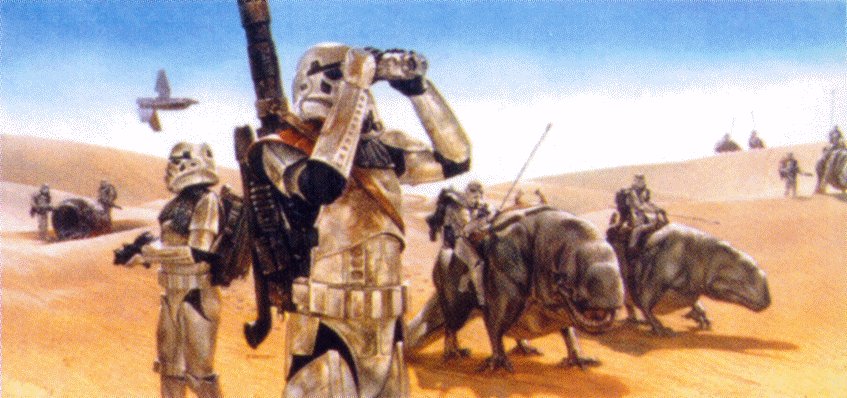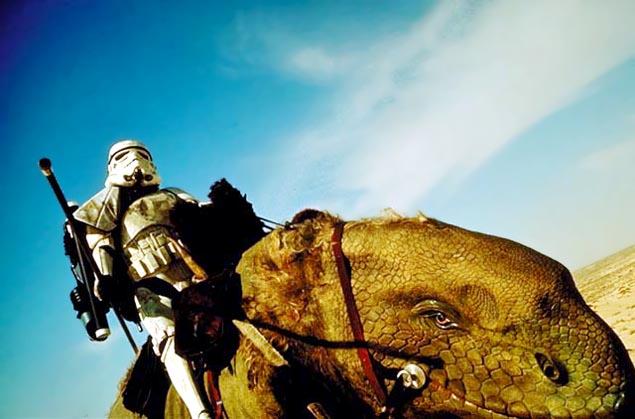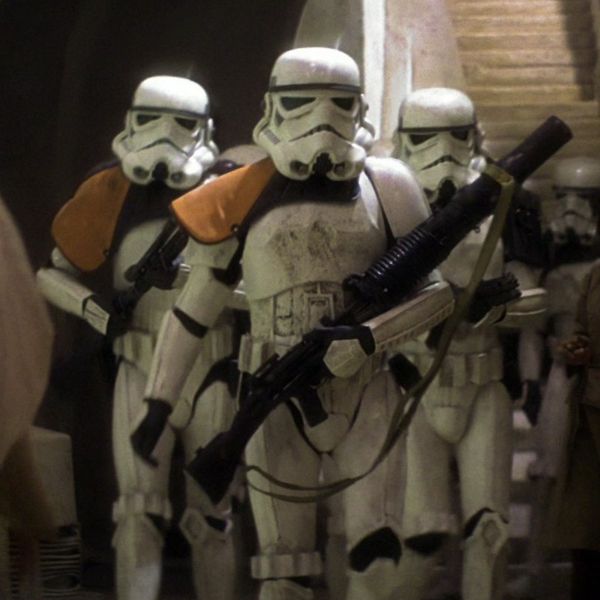

A sandtrooper, or desert trooper, is an Imperial stormtrooper equipped with modified armor and equipment to withstand the harsh climates of desert planets. They have additional training in specialized areas and advanced cooling systems in both their helmets and suits that offered them protection from the relentless heat.
Sandtrooper armor consists of an 18 piece anti-blaster cocoon shell like that of a standard stormtrooper, but also had a heat-reflective coating worn over a temperature-control body glove. The sandtrooper helmet featured automatic polarized lenses, a built-in comlink, and breathing filters. Visual differences in armor included a distinctive diamond shaped left knee plate, non-ribbed chest and back plate connectors as well as reinforced abdominal plating.
Standard weaponry sandtroopers employ are E-11 blaster rifles, DLT-19 heavy blaster rifles, T-21 light repeating blasters, or RT-97C heavy blaster rifles.
Camouflage and Concealment - This is an important item and great attention should be paid to it. Movement, color, shadow, and deception are all important features of the use of camouflage. Netting should be used effectively and practice should be completed in the erecting and disassembling of the camouflage cover. This is especially important for service and support troops as they are extremely vulnerable to attack.
Survival - All troopers who operate in the desert environment must be confident in their ability to survive in the harsh environment. Water must be checked as it may be contaminated with various substances that may not hurt the indigenous population, but may be extremely harmful to an offworlder.
Water is the third most important survival tool to a trooper. The first is his weapon and the second is any navigational tool that he has. Mirrors should also be considered extremely useful for signalling air or ground forces.
Thermal blankets and heaters should also be brought along in desert survival packages. While deserts are extremely hot during the daytime, many inexperienced troopers fail to realise that they can also be very cold at night. Quite a few soldiers have died from hypothermia after reassuring themselves that deserts would never get that cold.
Field Training - Following minimum training in the garrison, all desert troopers are expected to be able to know about heat related disorders, where to find the basic survival needs, navigate through a variety of methods in the desert, and to know basic fighting skills that are unique to desert fighting. After this garrison training, all desert course troopers are sent out on a 20 day field exercise where they learn how to fight and live in the desert.
The final exam is extremely tough. The trooper is dropped off in the middle of a desert wasteland and he must navigate back to the base over a distance of approximately 100 miles with just one canteen and his weapons. Only after this does he earn the title of Desert Trooper.

The basic navigation aide is the Magnetic compass. This does not work on a world that has multiple magnetic poles or has large amounts of metal. It also is adversely affected by power units and some metals such as those used in the construction of ground fighting vehicles.
Gyro Compasses are effective only on flat ground, but are useful for maintaining a certain direction.
Distance recorders are extremely helpful. The come in vehicles (odometers), but there are also hand held ones used by infantryman.
If in radio contact with friendly forces, artillery/mortar fire or smoke/illumination rounds can be fired off in order to help with direction finding or maintaining bearings.
GPS (Global Positioning Systems) is a spaced based, radio positioning navigation system that allows a trooper/officer/operational commander to be able to track and know the position that the units are located. This is readily available to troopers once aerial superiority over a planet allows the Imperial Navy to drop satellites in an orbit without fear of destruction by enemy craft.
Arial Photography allows a unit leader/trooper to be able to use his surroundings to figure out where they are in relation to terrain features.
Methods such as dead reckoning, the shadow-tip method, and the azimuth shoot are all effective when a trooper knows the exact times and rotations of the light producing astronomic bodies. They are extremely hard to use though when there are multiple light sources or the cycles change abruptly while on planet.
Tactical operations in the desert are based primarily on mobility. Whether this is achieved through the use of mechanized, aerial, or local beasts of burden (i.e. dewbacks), the simple fact remains the same. Speed through mobility wins the day usually. Normally, deserts are extremely crossable by way of ground transportation, but occasionally, things such as bogs during the rainy season or just the height of some dunes can lead to problems. These should be planned for ahead of time and dealt with in a rapid fashion.
Movement at night is in the best interests of tactical safety. There is less of a chance of a light source flashing on a shiny part of a vehicle or on a trooper. It is also usually less hot and not as physically exhausting to your personnel.
Another key to victory in desert tactical operations is to always be on the offensive. This is in lines with the mobility that must be had with desert units. To be found in the open desert by a larger force will almost always lead to extermination due to the fact that there isn't usually anywhere to fall back to.
Reconnaissance is the another major part of fighting in the desert environment. To find one’s enemy is half of the object in war. Once you find them, you must kill them in the most effective manner. Devotion of your resources must be spread between recon, anti-recon, security, aerial defense, and offensive ready forces.
Aerial defense should be another major priority due to the flatness of the desert terrain, which does not have many opportunities for cover and concealment. Use of vehicle and manheld weapons systems is a must in this environment.
Anti-Recon forces must be patrolling at a distance far enough away from the main force that the enemy recon forces have no concrete idea where your main forces are located.
Security forces for your main force must be able to protect from enemy saboteurs and sappers who may try to infiltrate your encampment. They should employ a number of weapons/tactics, including minefields, claymores, fortified fighting positions, OP's(Observation Posts), and sensors.
The main force, or the Offensive Ready Force, must be prepared to break camp at a moment's notice and go on the offensive. It must be highly mobile and have a large amount of firepower.
